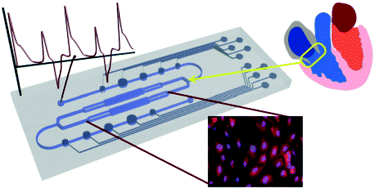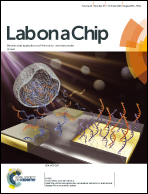A microfluidic cardiac flow profile generator for studying the effect of shear stress on valvular endothelial cells†
Abstract
To precisely investigate the mechanobiological responses of valvular endothelial cells, we developed a microfluidic flow profile generator using a pneumatically-actuated micropump consisting of microvalves of various sizes. By controlling the closing pressures and the actuation times of these microvalves, we modulated the magnitude and frequency of the shear stress to mimic mitral and aortic inflow profiles with frequencies in the range of 0.8–2 Hz and shear stresses up to 20 dyn cm−2. To demonstrate this flow profile generator, aortic inflow with an average of 5.9 dyn cm−2 shear stress at a frequency of 1.2 Hz with a Reynolds number of 2.75, a Womersley number of 0.27, and an oscillatory shear index (OSI) value of 0.2 was applied to porcine aortic valvular endothelial cells (PAVECs) for mechanobiological studies. The cell alignment, cell elongation, and alpha-smooth muscle actin (αSMA) expression of PAVECs under perfusion, steady flow, and aortic inflow conditions were analyzed to determine their shear-induced cell migration and trans-differentiation. In this morphological and immunocytochemical study, we found that the PAVECs elongated and aligned themselves perpendicular to the directions of the steady flow and the aortic inflow. In contrast, under perfusion with a fluidic shear stress of 0.47 dyn cm−2, the PAVECs elongated and aligned themselves parallel to the direction of flow. The PAVECs exposed to the aortic inflow upregulated their αSMA-protein expression to a greater degree than those exposed to perfusion and steady flow. By comparing these results to those of previous studies of pulsatile flow, we also found that the ratio of positive to negative shear stress plays an important role in determining PAVECs' trans-differentiation and adaptation to flow. This microfluidic cardiac flow profile generator will enable future valvular mechanobiological studies to determine the roles of magnitude and frequency of shear stresses.



 Please wait while we load your content...
Please wait while we load your content...